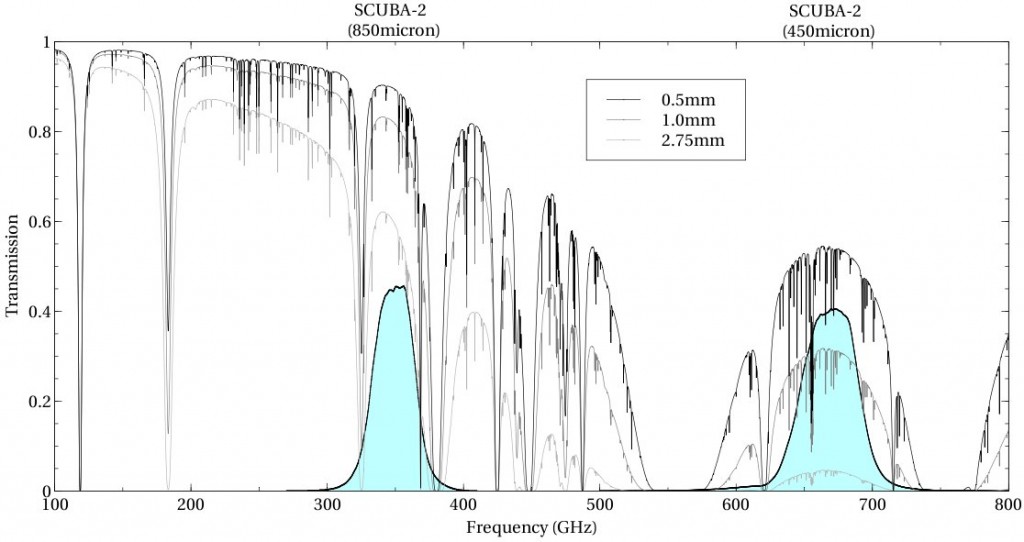Heterodyne Instrumentation
The JCMT currently has five heterodyne spectral instruments: HARP: a 16-pixel array receiver working at 345 GHz; ʻŪʻū: a single-pixel insert on Nāmakanui working at 230 GHz; ʻĀweoweo: a single-pixel insert on Nāmakanui working at 345 GHz; ʻAlaʻihi, a single pixel insert on Nāmakanui working at 86 GHz and primarily intended for VLBI. In addition, Kuntur is a 690 GHz receiver from LLAMA which replaces ʻĀweoweo in the Nāmakanui cartridge for planned time-limited campaigns, usually in the winter. The backend for all of these heterodyne instruments is the ACSIS correlating spectrometer.

Plot of transmission as a function of frequency for different levels of precipitable water vapor. The two current heterodyne receivers HARP and RxA are shown in relation to this.
Continuum Instrumentation
SCUBA-2 is the JCMT’s continuum camera. It has four 32×40 detector arrays at 850 and 450 micron, in total 10240 detectors. SCUBA-2 operations are currently paused.

Plot of transmission as a function of frequency for different levels of precipitable water vapor. The SCUBA-2 450 and 850 micron filters are shown in relation to this. It is clearly evident that 450 micron data requires good weather conditions due to the atmospheric window.
Current Status
Last update: December 11th 2025.
Operational
- Nāmakanui – ʻŪʻū
- Nāmakanui – ʻAlaʻihi (86 GHz, undergoing commissioning)
- Nāmakanui – Kuntur (690 GHz, currently being commissioned)
- ACSIS – backend digital spectronometer
- WVM – Water Vapor Monitor (for weather see here)
Temporarily unavailable due to engineering work
Anticipated time off the telescope is Nov 19th 2025 to ~Dec 20th 2025.
Currently not installed
The ʻĀweoweo cartridge is being temporarily removed from the Nāmakanui cartridge as of November 7th 2025, and replaced with the 625 GHz cartridge Kuntur. The exact date to swap back has not been selected but is anticipated to be in Spring 2026.
Operations Paused
As announced to the JCMT community in 2025, operations with SCUBA-2 (and its polarimeter POL-2) are currently paused.
| Instrument | Comments |
|---|---|
| SCUBA-2 |
|
| HARP |
|
| ʻŪʻū |
|
| ʻĀweoweo |
|
| ʻAlaʻihi |
|
| Kuntur |
|
| ACSIS |
|
| WVM |
|
Not Operational/Retired:
| Instrument | Comments |
|---|---|
| RxA
|
|
| RxW |
|



